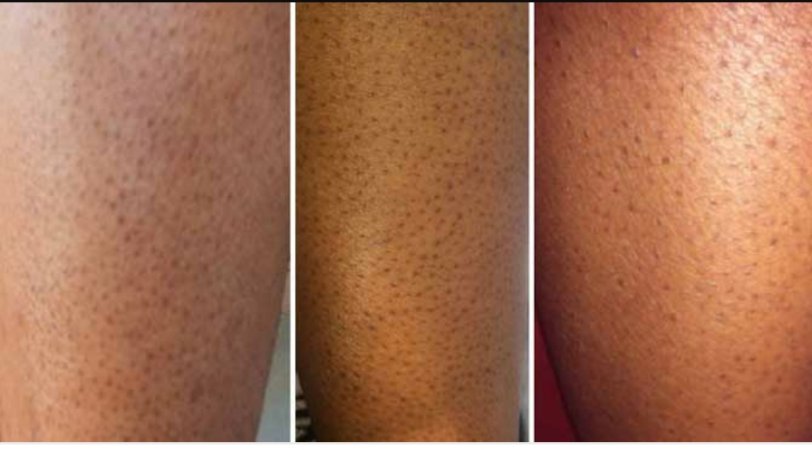Our skin is a fussy thing. No matter how much we invest in it and try to keep it flawless, it always seems like we are missing something.
It panics and freaks out during the cold winter months, and it does pretty much the same during the warm time of the year, bringing on a whole new myriad of challenges to deal with, leaving us completely puzzled.
Summer is the season of scorching heat, sandy beaches, turquoise seas, refreshing cocktails, and short dresses.
But having your legs covered with tiny dark spots is definitely something that doesn’t fit in this idyllic picture.
Oh, did you think you are the only one with this problem?
You most certainly aren’t.
Strawberry legs are quite common that you actually have to consider yourself lucky if you don’t have them.
In this article, I’m going to show how to get rid of strawberry legs (keratosis pilaris) as well as explain a few things that cause them so you can prevent them in the future.

5 Ways To Get Rid of Strawberry Legs (An Esthetician Explains)
Depending on the cause and severity, strawberry legs can be treated and prevented with several home remedies and professional treatments.

Exfoliate Your Skin Before Shaving
By exfoliating your skin before shaving, you remove the dirt, bacteria, and dead skin cells that can potentially clog the pores and lead to strawberry legs.
Removing dead skin cells on your legs will give new hair the chance of breaking through the skin’s surface more easily instead of remaining embedded into the hair follicle.
Shave Correctly
Avoid using an old and dull razor repeatedly on your skin.
Old razors accumulate tons of bacteria and dead skin cells from the previous shaving and can spread the existing gunk into the open pores on the surface of the skin.
Irritation can easily occur that can lead to strawberry legs, as well as painful and uncomfortable rashes and inflammation.
It is recommendable to change your razors after 3-4 uses to avoid this.
Also, always shave following the direction of hair growth and avoid passing over the area too many times so that you reduce irritation on the skin.
Use a Shaving Cream
Apply shaving cream following the direction of the hair growth to create a protective barrier between your skin and the blade.
This will not only make the blade to glide smoothly across the skin, but it will also reduce the chance of irritation on the skin.
Use a gentle aloe-based cream or gel due to its anti-inflammatory and soothing properties.
Moisturize Your Skin Daily
By moisturizing your skin, you will replace the lost moisture and improve the suppleness of your skin. This will relieve the symptoms of strawberry legs or rashes caused by shaving.
Get a Professional Treatment
If at-home remedies are not effective, and your condition is becoming noticeably aggravated, you can also treat it with the help of a trained professional in a clinical setting.
Possible treatments to prevent the bumps and rashes related to constant shaving may include:
- Laser therapy – this is a precise treatment of permanent hair removal that will require multiple treatments but it is highly effective. The laser therapy process typically occurs three to seven times will effectively get rid of the hair and prevent further inflammation.
- Electrolysis – this treatment consists of using low levels of electrical current to pinpoint irritated hair follicles. Electrolysis prevents ingrown hairs from recurring and is intended to treat smaller areas, such as the chin, upper lip, and the area around the nipples.
What Causes Strawberry Legs?
Strawberry legs are dark spots or bumps on your legs that resemble the seeds on the skin of a strawberry.
These are essentially open comedones (enlarged pores) that contain a mixture of oil, bacteria, and dead skin cells that are trapped inside the follicles.
When the pore is exposed to air, typically after shaving, this mixture darkens in color and is very much visible on the skin’s surface.
There are several different conditions that can cause the appearance of strawberry legs. These are some of them:
Shaving
We can all agree that throwing a razor after one use is outrageous, but as it turns out these should be changed pretty often.
Shaving improperly with dull and old razors can cause strawberry legs or exacerbate existing marks as the skin around the follicle may darken due to the irritation from continuous shaving.
Dull razor blades may also be causing you to develop ingrown hair.
Store your blade in a dry place between uses so you can prevent rust and the spread of dead skin cells and bacteria.
Clogged Pores
Pores enlarge due to excess production of sebum which is the skin’s oil and natural moisturizer. This can attract dirt, bacteria, and dead skin cells and trap them inside the skin, causing the pore to become clogged.
Clogged pores are called open comedones, and they turn dark after being exposed to the air. This is because the oil and gunk inside the pores darken once it’s dry.
Dry Skin
Dry skin is unfortunately very vulnerable and likely to develop irritation after shaving. This can lead to the appearance of strawberry legs, keratosis pilaris, and even folliculitis.
It can also become the cause of a painful and uncomfortable rash known as razor burn.
Excessive dryness often encourages the darkening of pores on the skin, making these conditions even more prominent and obvious to the eye.
Dry skin is not a dangerous condition. However, the skin can often become unbearably tight and uncomfortable. If left neglected for a long time, it can lead to serious epidermal damage like cracking and infections.
Find out how to naturally treat dry skin with these simple remedies.
Keratosis Pilaris
Keratosis pilaris is a benign and prevalent condition.
The small bumps associated with keratosis pilaris look like tiny pimples, darkened goosebumps, or commonly referred to as “chicken skin”.
These are typically rough and hard to the touch and are considered to be accumulations of keratin build-up, which is the hard and durable protein on our skin and dead skin cells.
Keratosis pilaris may become aggravated during the summer months, especially if you often visit swimming pools due to the harsh chemicals used to maintain the water clean.
It can be itchy and while there’s no cure for this harmless condition, it can be treated and soothed with moisturizing creams.
Folliculitis
Folliculitis occurs when infected hair follicles become inflamed.
This condition may be the result of shaving or waxing, as these two methods of hair removal leave the hair follicle open and this exposure increases the risk of infection.
Folliculitis can also occur if exposed to bacteria, yeast, or fungus that can successfully thrive inside the skin and infect the hair follicles.
While strawberry legs are typically easily managed, for some people this benign condition can cause further complications.
Prevention measures and home remedies can go a long way, so you can successfully eliminate a mild appearance of strawberry legs on your own.
I hope this article has given you clear insights into getting rid of strawberry legs – let me know if you have any questions down below.

My name is Simone and I am a certified skin specialist. I created this website to teach my readers how to take great care of their skin and I also like to occasionally share my honest opinions on skincare products I’ve tried. You can learn more about me here.

I always find your topics very helpful! Thanks!
I’m so happy I can help!<3